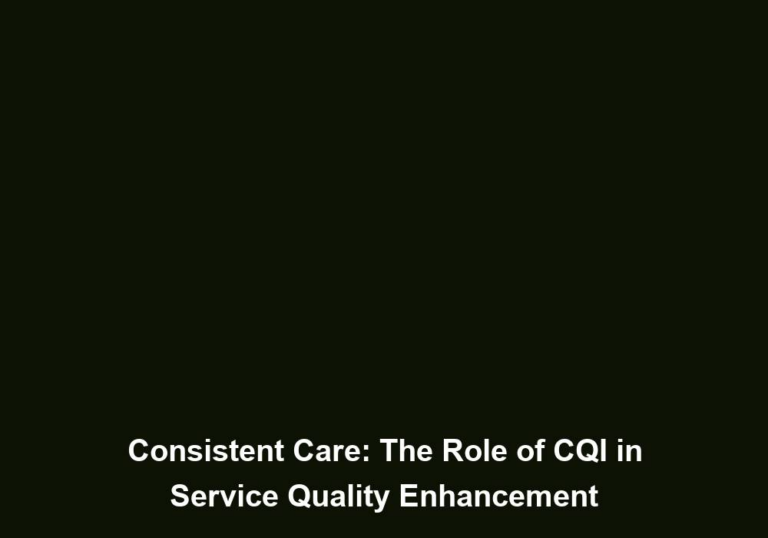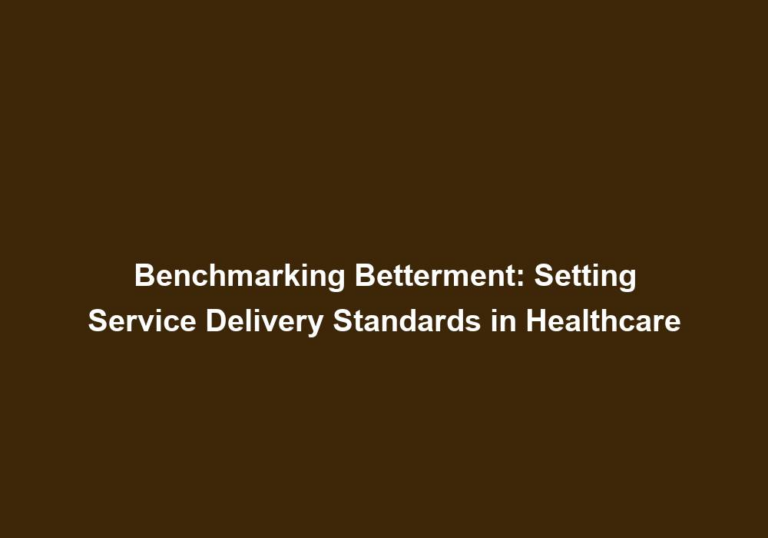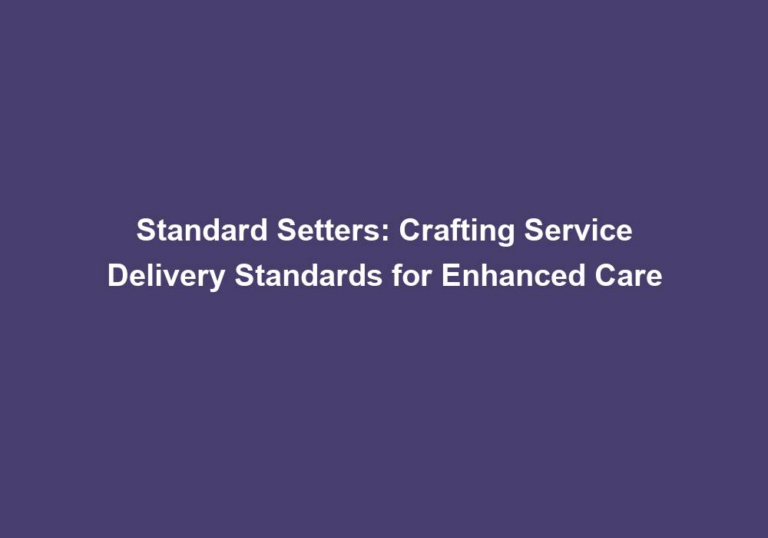From Good to Great: Uplifting Service with Optimal Delivery Standards
In today’s highly competitive business landscape, delivering exceptional customer service has become more critical than ever. Customers have increasingly high expectations, and meeting those expectations is the key to not just retaining your existing customer base but also attracting new customers. One of the crucial aspects of providing outstanding service lies in setting optimal delivery standards. This article explores how businesses can transition from good to great by upholding these standards.
Understanding the Importance of Optimal Delivery Standards
Optimal delivery standards refer to the set of guidelines and practices that businesses implement to ensure prompt, efficient, and satisfactory delivery of products or services to their customers. By establishing and maintaining these standards, businesses can create a positive and memorable customer experience, leading to increased customer satisfaction and loyalty.
To truly understand the importance of optimal delivery standards, it is essential to recognize the impact it has on customer satisfaction. When businesses consistently meet or exceed delivery expectations, customers feel valued and satisfied with their overall experience. This satisfaction not only promotes customer loyalty but also encourages repeat business. Moreover, implementing optimal delivery standards helps businesses build a strong reputation for reliability and efficiency. Positive word-of-mouth and online reviews from satisfied customers contribute to attracting new customers and expanding the customer base.
The Benefits of Optimal Delivery Standards
Implementing optimal delivery standards provides businesses with numerous benefits that contribute to their success and growth. Let’s explore some of these benefits in detail:
- Enhanced Customer Satisfaction:
- Meeting or exceeding delivery expectations consistently makes customers feel valued and satisfied with their overall experience.
- This satisfaction promotes customer loyalty and encourages repeat business.
- Establishing optimal delivery standards ensures that businesses prioritize customer satisfaction and create positive and memorable customer experiences.
- Improved Reputation:
- Businesses that implement optimal delivery standards build a strong reputation for reliability and efficiency.
- Positive word-of-mouth and online reviews from satisfied customers contribute to attracting new customers and expanding the customer base.
- A good reputation for timely and efficient delivery can set a business apart from its competitors in a crowded marketplace.
- Competitive Advantage:
- In a highly competitive marketplace, businesses that prioritize optimal delivery standards gain a significant competitive edge.
- Customers are more likely to choose a company that offers reliable and efficient delivery over its competitors.
- By setting optimal delivery standards, businesses can differentiate themselves and attract a larger customer base.
- Reduced Costs:
- Implementing optimal delivery standards can help businesses reduce costs associated with rework, returns, and customer complaints.
- By streamlining delivery processes and minimizing errors or delays, businesses can improve their overall efficiency.
- Efficient delivery practices also contribute to a more cost-effective supply chain management.
Key Elements of Optimal Delivery Standards
To achieve optimal delivery standards, businesses must focus on the following key elements:
1. Speed and Efficiency
Fast and efficient delivery is essential to meet customer expectations in today’s instant gratification society. Implementing strategies to expedite order processing, minimize wait times, and reduce delivery lead times can significantly enhance customer satisfaction.
- Minimizing order processing time: Implementing efficient order management systems and automating processes can help reduce the time it takes to process an order, ensuring a quicker turnaround.
- Streamlining logistics: Optimizing delivery routes, leveraging technology for route planning, and partnering with reliable shipping providers can help businesses achieve faster and more efficient deliveries.
- Real-time tracking: Providing customers with real-time tracking information allows them to stay informed about the status and location of their orders, enhancing transparency and reducing anxiety.
2. Accuracy and Reliability
Ensuring accurate order fulfillment and reliable delivery is crucial for building trust with customers. Businesses should invest in robust inventory management systems and shipping partners to minimize errors, track shipments effectively, and provide real-time updates to customers.
- Inventory management: Implementing an advanced inventory management system allows businesses to accurately track stock levels, reducing the risk of overselling or stockouts.
- Shipping partner selection: Partnering with reliable shipping providers with a proven track record of timely and error-free deliveries ensures that customers receive their orders as expected.
- Real-time updates: Providing customers with real-time updates about their orders, such as shipping notifications and delivery confirmations, enhances transparency and builds trust.
3. Communication and Transparency
Maintaining open lines of communication and transparency throughout the delivery process is paramount. Businesses should provide customers with clear tracking information, estimated delivery times, and proactive notifications in case of any delays or issues.
- Clear communication: Establishing clear and concise communication channels with customers, such as email, SMS, or chat support, allows businesses to provide timely updates and address any queries or concerns promptly.
- Estimated delivery times: Setting realistic and accurate estimated delivery times helps manage customer expectations and reduces any potential frustration caused by delays.
- Proactive notifications: In the event of delays or issues during the delivery process, businesses should proactively notify customers, providing them with transparent information and potential solutions.
4. Quality Packaging and Presentation
Packaging plays a vital role in delivering products in pristine condition. Investing in quality packaging materials and design not only protects the products but also enhances the overall unboxing experience for customers, leaving a lasting impression.
- Protective packaging: Using appropriate packaging materials, such as bubble wrap, air cushions, or padded envelopes, helps prevent damage during transit and ensures that products arrive in perfect condition.
- Branding and design: Customizing packaging with the brand logo, colors, and attractive design elements enhances the unboxing experience, making it more memorable for customers.
- Sustainable packaging: Prioritizing environmentally friendly packaging materials demonstrates a commitment to sustainability, which can resonate with eco-conscious customers.
5. Continuous Improvement and Feedback
To uphold optimal delivery standards, businesses must constantly evaluate their processes, seek customer feedback, and make necessary improvements. Regularly monitoring key performance indicators related to delivery can help identify areas of improvement and implement corrective actions.
- Performance tracking: Monitoring key performance indicators (KPIs) such as on-time delivery rate, customer satisfaction scores, and delivery cost per order provides businesses with valuable insights into their delivery performance.
- Customer feedback: Actively seeking customer feedback through surveys, reviews, and social media platforms helps identify specific pain points and areas for improvement in the delivery process.
- Process optimization: Analyzing delivery data and customer feedback allows businesses to identify trends, bottlenecks, and areas for improvement. Implementing process enhancements and making necessary adjustments ensures continuous improvement.
Best Practices for Maintaining Optimal Delivery Standards
To consistently deliver exceptional service, businesses should incorporate the following best practices:
-
Conduct regular training sessions for employees involved in the delivery process to ensure they understand and adhere to the established delivery standards. Training should cover topics such as order processing, handling customer inquiries, and resolving delivery-related issues.
-
Implement a robust quality control system to detect and rectify any errors or issues before the products reach the customers. This can include conducting quality checks at different stages of the delivery process, such as order picking, packaging, and final inspection.
-
Leverage technology to automate and streamline delivery processes, such as order tracking, real-time inventory management, and delivery route optimization. Utilizing software solutions and integrating systems can improve efficiency, reduce errors, and enhance the overall delivery experience.
-
Foster a customer-centric culture within the organization, emphasizing the importance of delivering outstanding service at every touchpoint. Encouraging employees to prioritize customer satisfaction and providing incentives for exceptional service can help create a customer-centric mindset.
-
Establish strong partnerships with reliable shipping providers and negotiate favorable terms to ensure timely and cost-effective deliveries. Regularly evaluating shipping providers based on their performance, service quality, and pricing allows businesses to make informed decisions and maintain optimal delivery standards.
-
Monitor customer feedback channels, such as surveys, reviews, and social media, and respond promptly to address any concerns or issues raised by customers. Demonstrating responsiveness and a commitment to resolving customer problems can significantly enhance customer satisfaction and loyalty.
-
Regularly analyze delivery data and key performance indicators to identify trends, bottlenecks, and areas for improvement. Conducting regular performance reviews and implementing data-driven insights enable businesses to continuously optimize their delivery processes and maintain optimal standards.
By following these best practices and prioritizing optimal delivery standards, businesses can elevate their customer service from good to great, setting themselves apart from the competition and securing long-term success.






